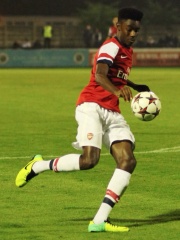ATHLETE
Yndiara Asp
1997 - Today

 Yndiara Asp
Yndiara Asp
Yndiara Asp (born 19 October 1997) is a Brazilian professional skateboarder, who represented Brazil in the 2021 Tokyo Olympics. Read more on Wikipedia
Her biography is available in 3 different languages on Wikipedia. Yndiara Asp is the 11,099th most popular athlete (down from 8,584th in 2024), the 2,662nd most popular biography from Brazil (down from 2,335th in 2019) and the 144th most popular Brazilian Athlete.
Memorability Metrics
Page views of Yndiara Asp by language
Among ATHLETES
Among athletes, Yndiara Asp ranks 11,099 out of 6,025. Before her are Sanzhar Mussayev, Isabella Straub, Nur Shazrin Mohd Latif, Laura Ilie, Roland Gálos, and Kyle Greaux. After her are Charlotte Fry, Mohamed Saadaoui, Ariana Ince, Jaqueline Ferreira, Dina Aspandiyarova, and Teresa Bonvalot.
Most Popular Athletes in Wikipedia
Go to all RankingsSanzhar Mussayev
1996 - Present
HPI: 20.37
Rank: 11,095
Isabella Straub
1991 - Present
HPI: 20.36
Rank: 11,096
Nur Shazrin Mohd Latif
1998 - Present
HPI: 20.36
Rank: 11,097
Laura Ilie
1993 - Present
HPI: 20.36
Rank: 11,098
Roland Gálos
1995 - Present
HPI: 20.36
Rank: 11,099
Kyle Greaux
1988 - Present
HPI: 20.35
Rank: 11,100
Yndiara Asp
1997 - Present
HPI: 20.35
Rank: 11,101
Charlotte Fry
1996 - Present
HPI: 20.34
Rank: 11,102
Mohamed Saadaoui
1995 - Present
HPI: 20.33
Rank: 11,103
Ariana Ince
1989 - Present
HPI: 20.32
Rank: 11,104
Jaqueline Ferreira
1987 - Present
HPI: 20.32
Rank: 11,105
Dina Aspandiyarova
1976 - Present
HPI: 20.32
Rank: 11,106
Teresa Bonvalot
1999 - Present
HPI: 20.32
Rank: 11,107
Contemporaries
Among people born in 1997, Yndiara Asp ranks 1,495. Before her are Lucy Hope, Arthur De Sloover, Teagan Micah, Liam Corrigan, Daniils Bobrovs, and Jamie Yeung. After her are Chen Qingyuan, Maximilian Brandl, Dilara Bozan, Aishath Sajina, Stefan O'Connor, and Ira Eliezer Tapé.
Others Born in 1997
Go to all RankingsLucy Hope
SWIMMER
1997 - Present
HPI: 20.55
Rank: 1,490
Arthur De Sloover
ATHLETE
1997 - Present
HPI: 20.53
Rank: 1,491
Teagan Micah
SOCCER PLAYER
1997 - Present
HPI: 20.49
Rank: 1,492
Liam Corrigan
ATHLETE
1997 - Present
HPI: 20.44
Rank: 1,493
Daniils Bobrovs
SWIMMER
1997 - Present
HPI: 20.37
Rank: 1,494
Jamie Yeung
SWIMMER
1997 - Present
HPI: 20.36
Rank: 1,495
Yndiara Asp
ATHLETE
1997 - Present
HPI: 20.35
Rank: 1,496
Chen Qingyuan
FENCER
1997 - Present
HPI: 20.29
Rank: 1,497
Maximilian Brandl
ATHLETE
1997 - Present
HPI: 20.27
Rank: 1,498
Dilara Bozan
ATHLETE
1997 - Present
HPI: 20.26
Rank: 1,499
Aishath Sajina
SWIMMER
1997 - Present
HPI: 20.26
Rank: 1,500
Stefan O'Connor
SOCCER PLAYER
1997 - Present
HPI: 20.25
Rank: 1,501
Ira Eliezer Tapé
SOCCER PLAYER
1997 - Present
HPI: 20.22
Rank: 1,502
In Brazil
Among people born in Brazil, Yndiara Asp ranks 2,662 out of 2,236. Before her are Luiz Francisco (2000), Hampton Morris (2004), Chayenne da Silva (2000), Dora Varella (2001), Gabrielle Roncatto (1998), and Ketiley Batista (1999). After her are Mohamed Saadaoui (1995), Jaqueline Ferreira (1987), Vinícius Teixeira (1988), Radwa Abdel Latif (1989), Samory Fraga (1996), and Lucas Carvalho (1993).
Others born in Brazil
Go to all RankingsLuiz Francisco
ATHLETE
2000 - Present
HPI: 21.06
Rank: 2,656
Hampton Morris
ATHLETE
2004 - Present
HPI: 20.99
Rank: 2,657
Chayenne da Silva
ATHLETE
2000 - Present
HPI: 20.86
Rank: 2,658
Dora Varella
ATHLETE
2001 - Present
HPI: 20.71
Rank: 2,659
Gabrielle Roncatto
SWIMMER
1998 - Present
HPI: 20.70
Rank: 2,660
Ketiley Batista
ATHLETE
1999 - Present
HPI: 20.60
Rank: 2,661
Yndiara Asp
ATHLETE
1997 - Present
HPI: 20.35
Rank: 2,662
Mohamed Saadaoui
ATHLETE
1995 - Present
HPI: 20.33
Rank: 2,663
Jaqueline Ferreira
ATHLETE
1987 - Present
HPI: 20.32
Rank: 2,664
Vinícius Teixeira
HANDBALL PLAYER
1988 - Present
HPI: 20.28
Rank: 2,665
Radwa Abdel Latif
ATHLETE
1989 - Present
HPI: 20.21
Rank: 2,666
Samory Fraga
ATHLETE
1996 - Present
HPI: 20.16
Rank: 2,667
Lucas Carvalho
ATHLETE
1993 - Present
HPI: 20.15
Rank: 2,668
Among ATHLETES In Brazil
Among athletes born in Brazil, Yndiara Asp ranks 144. Before her are Carlos Paro (1979), Luiz Francisco (2000), Hampton Morris (2004), Chayenne da Silva (2000), Dora Varella (2001), and Ketiley Batista (1999). After her are Mohamed Saadaoui (1995), Jaqueline Ferreira (1987), Radwa Abdel Latif (1989), Samory Fraga (1996), Lucas Carvalho (1993), and Kawan Pereira (2002).
Carlos Paro
1979 - Present
HPI: 21.11
Rank: 138
Luiz Francisco
2000 - Present
HPI: 21.06
Rank: 139
Hampton Morris
2004 - Present
HPI: 20.99
Rank: 140
Chayenne da Silva
2000 - Present
HPI: 20.86
Rank: 141
Dora Varella
2001 - Present
HPI: 20.71
Rank: 142
Ketiley Batista
1999 - Present
HPI: 20.60
Rank: 143
Yndiara Asp
1997 - Present
HPI: 20.35
Rank: 144
Mohamed Saadaoui
1995 - Present
HPI: 20.33
Rank: 145
Jaqueline Ferreira
1987 - Present
HPI: 20.32
Rank: 146
Radwa Abdel Latif
1989 - Present
HPI: 20.21
Rank: 147
Samory Fraga
1996 - Present
HPI: 20.16
Rank: 148
Lucas Carvalho
1993 - Present
HPI: 20.15
Rank: 149
Kawan Pereira
2002 - Present
HPI: 19.90
Rank: 150




































